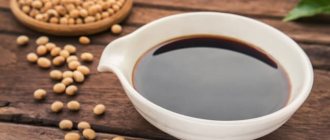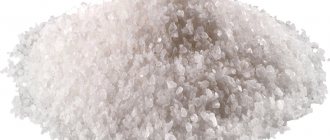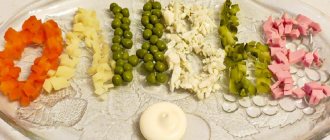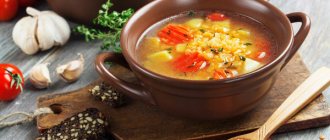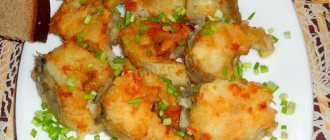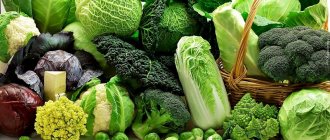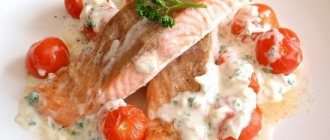Pesto sauce is a signature seasoning of Italian cuisine, which is served with all dishes - salads, soups and main dishes. The full name of the product is pesto Genovese a la Olivia, where the first word means the method of preparation, and the last is the main ingredient. Indeed, the main ingredients in the classic recipe are olive oil, green basil and sheep cheese, sometimes of several varieties. The delicate sauce does not look very appetizing - a green, heterogeneous paste. But the taste is described differently, noting nutty-olive or cheese-garlic notes. Despite the seemingly incompatible ingredients, it is possible to obtain a harmonious composition.
Pesto
| Products | Weight (g) | Kcal | B(g) | F (g) | U(g) |
| Almond | 20 | 122 | 4 | 11 | 3 |
| Parsley | 100 | 47 | 4 | 8 | |
| Olive oil | 100 | 898 | — | 100 | — |
| Cilantro | 100 | 49 | 4 | 8 | |
| Total: | 320 | 1116 | 11 | 111 | 18 |
| For 1 serving: | 32 | 112 | 1.1 | 11.1 | 1.8 |
| Per 100 grams: | 349 | 3.5 | 34.8 | 5.7 | |
| BJU: | 4% | 90% | 6% |
Ingredients:
Pack of cilantro Pack of parsley 0.5 cup cold pressed olive or sesame oil. 6-9 almonds, pre-soaked and peeled, or some pine nuts 1/3 teaspoon salt.
Method of preparation: Pour water over the cilantro and parsley and rinse well. Place the greens in boiling water for a few seconds (until a bright green color appears), cool, add nuts and grind in a blender. Add the oil and salt and stir for a few more seconds.
Possible additions: 1 clove of garlic - add while grinding the herbs. 1 tablespoon of pumpkin seeds to enrich the taste - add while grinding the greens. You can also make sauce from any other herbs - basil, dill. To prevent the sauce from darkening, you can lightly pour oil on top.
Source
Recipes with pesto sauce
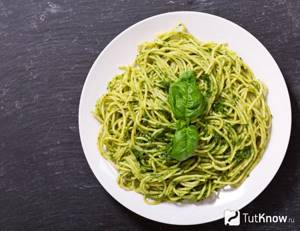
This seasoning goes well with first courses, salads and even desserts. This additive gives the most ordinary products an original taste.
Recipes with pesto sauce:
- Sand baskets
. The sauce is prepared according to the classic recipe. Beat 100 g of butter with 125 g of sugar with a mixer, add an egg, a pinch of vanillin and 2/3 teaspoons of baking powder. Stir, combine with flour - 250 g, add salt. The batch is wrapped in cling film and left for an hour on the refrigerator shelf. Preheat the oven to 220°C, grease the cake pans with sunflower oil. Roll out identical lumps of dough, place them in molds, and press down to distribute the dough along the walls. Bake for 10-15 minutes. Vegetables of your choice are grilled. Cut into small pieces, put in molds, put in the oven for 2 minutes. Before serving, spread pesto on top. - Chicken breasts
. The fillet is cut into small portions and placed on a hot frying pan. Stir constantly until a golden brown crust appears. When the meat is half fried, pour white wine into the pan and add spices to taste. The fried chicken is mixed, without removing from the heat, with sour cream and red pesto. As soon as everything boils, you can turn it off. Potatoes are served as a side dish. - Squid with pesto
. Potatoes are fried in vegetable oil until golden brown. Longitudinal cuts are made on the squid fillets and left to marinate in olive oil and red pepper. 10 minutes before the potatoes are ready, place the fillets on a baking sheet. Served with green pesto and cilantro. - Pasta with pesto
. Knead the dough from 2 eggs and 500 g of premium wheat flour, adding a little salt. When the mixture is very dense, pour in a little ice water. Let it sit for 30 minutes so it can “rest.” If you have a food processor attachment, it will be easier to make pasta. If not, roll out the dough into thin layers, sprinkle with flour, fold several times and cut into thin strips. The finished noodles are laid out in one layer to dry. Boil for 10 minutes, mix with pesto before serving. - Soup
. Beans, 100 g, soaked overnight, boil until tender in cold water. Peel and cut vegetables - onions, zucchini, carrots, bell peppers. Carrots and onions are fried in a frying pan until golden brown, the remaining vegetables are cut into small cubes. All ingredients are placed in a saucepan, 80 g of small vermicelli are added. Salt and pepper are added just before turning off. When serving, add 1 tbsp to each plate. l. pesto sauce.
Pesto
Pesto sauce is a classic example of the national Italian temperament and flavor. The perky green sauce pleases the eye and pleases the stomach, the aroma of pesto sauce is so bright and inviting that it is impossible to resist it under any circumstances. Historians and researchers believe that the ancestor of modern pesto sauce was known long before the Roman Empire, and its authorship is attributed to the ancient Persians. It is known for certain that sailors from Genoa had their own distinctive aroma at any time of the year - the smell of fresh basil. After all, pesto sauce could be stored much longer than any fresh herbs.
In a classic Italian recipe for pesto sauce, we will never see the proportions of the ingredients, only a mention of which products from which region are preferable. This is the beauty and zest of Italian cuisine - there will never be two identical dishes, there is always a lot of scope for creativity and imagination.
Pesto sauce calories
The calorie content of pesto sauce is 454 kcal per 100 grams of product.
Ingredients of pesto sauce
The chemical composition of pesto sauce includes: vitamins A, B1, B2, B5, B6, B12, C, D, E, K and PP, as well as potassium, calcium, magnesium, copper and manganese, iron, zinc, phosphorus and sodium .
The pesto sauce should contain fresh basil (necessarily green, “lemon”), extra virgin olive oil, garlic, Pecorino cheese (of course, you can replace it with Parmesan), pine seeds (pine nuts, only large ones) and sea salt.
Pesto sauce in cooking
The ideal way to make pesto is to use a mortar and pestle, preferably made of marble, but a ceramic one will also work. The use of metal (blender blades) will degrade the taste of the pesto and affect the color.
The main “trick” of the preparation is that by grinding green basil leaves with large crystals of sea salt, you achieve that very consistency and uniformity of the sauce, which is important (calorizer). Cheese, grated on the finest grater, will give the sauce softness and richness, and butter, added at the very end of cooking, will bring the whole dish together.
Calorie calculation for 100 grams
As an example, we will calculate a portion equal to 100 grams - this is one of the standard weight measures that determines the total calorie content of a product or recipe.
The easiest and most versatile option (suitable for calculating any volume of a product or ready-made dish) is calculation by multiplying the resulting calorie content (250 grams) by a factor of 0.4, which is the result of division (100 g / 250 g).
Calorie content of 100 grams of serving = 1917.3 * 0.4 = 767 kcal.
In addition, in the same way you can calculate the content of BZHU in the composition of a portion:
- Protein = 26.17 * 0.4 = 10.468 ≈ 10.5 g.
- Fats = 198.39 * 0.4 = 79.356 ≈ 79.4 g.
- Carbohydrates = 6.77 * 0.4 = 2.708 ≈ 2.7 g.
10.5 * 4 + 79.4 * 9 + 10.8 * 4 ≈ 767 kcal
Our calculated calorie content is more than 250 kcal, which means that pesto pasta is a high-calorie dish, high in protein, fat and low in carbohydrates.
Homemade sauce - how to prepare?
Real Pesto alla genovese is prepared from Genoese basil , pine nuts or pine pine seeds, hard sheep cheese, extra virgin olive oil. The ingredients are ground in a mortar and mixed. And it is always green.
You can prepare another, red, Pesto, if you use certain conditions:
- add fresh tomatoes and remove nuts (seeds);
- take sun-dried tomatoes and almonds, but do without cheese;
- also with fresh tomatoes without peel and seeds and almonds, but without cheese and pine seeds.
There are other cooking options when walnuts, hazelnuts, almonds, and peanuts are added instead of pine nuts. And even sunflower seeds have a place in home recipes.
Make a base with purple basil instead of green. It is better to take young sprigs of grass, then the dish will be juicy and rich. It should not be spoiled by overgrown stems.
Mint, arugula, dill, parsley, cilantro and spinach are added as additional seasonings or, in general, make an oil dressing from them. But it’s better not to forget about the main component; it is basil that brings a real Italian touch to the sauce, the rest of the herbs will add volume and original taste.
The piquancy can be enhanced with a mixture of peppers, sun-dried tomatoes, and garlic.
Of course, the sauce turns out tasty and aromatic, but it is still recommended to leave hard Parmesan cheese and good extra virgin unchanged.
How to prepare Pesto sauce in any of its varieties?
It’s very simple - if you have time, desire and availability of products.
The ratio of ingredients based on the classic recipe that should be followed:
- green basil (bunch) – 100 gr.,
- hard sheep cheese – 100 gr.,
- pine nuts – 80 gr.,
- olive oil – 150 gr.,
- garlic – 2 cloves,
- a pinch of sea salt.
Lay out all the products in advance; they should be at room temperature.
Step-by-step preparation:
- Wash the basil greens and dry them. Tear into large pieces.
- Grind the chopped pine nuts and peeled garlic in a mortar (bowl).
- Add the prepared basil and sea salt and rub in a circular motion.
- Add shredded cheese and knead everything well again.
- Add olive oil and stir until smooth. The result is an fragrant, homogeneous, soft-dense mass that does not spread when spread.
The true process is slow and long. Of course, you can speed it up by using a blender or meat grinder. Then preparing the butter sauce will take just a few minutes.
Pesto sauce is suitable for any dish. It can be a stand-alone dressing or used in combination with other ingredients.
In addition to the traditional and tasty combination with pasta and macaroni, Pesto successfully harmonizes:
- with fish, giving it piquancy and tenderness;
- with meat and poultry as a marinade, gravy, instead of ketchup and gravy;
- with pizza, replacing tomato sauce or adding a new taste and aroma;
- with any cooked and fresh vegetables;
- in salad as a dressing instead of mayonnaise, vegetable oil, sour cream;
- with any pasta and pasta;
- with rice (especially in risotto);
- in pies, on bread and sandwiches, crackers.
In addition, the sauce can be used as a seasoning, added to marinades, pie dough and even to soup.
Homemade dressing can be stored in the refrigerator in a tightly sealed container or jar. Implementation time is up to two weeks.
Pesto
How to prepare pesto sauce
- Rinse the basil with cool water and separate the leaves from the stems.
- Dry the basil leaves well.
- Peel the garlic and cut into petals.
- Grate the cheese.
- Place some of the basil in a blender bowl (the leaves can be coarsely chopped first).
- Add cheese, pine nuts, garlic to the basil and pour in 2-3 tablespoons of olive oil.
- Grind the ingredients in a blender, gradually adding the remaining basil leaves to the mixture and adding olive oil.
- The sauce does not need to be blended until smooth, just to chop and mix the ingredients.
- Basil – 50 gr.
- Parmesan cheese – 50 gr.
- Pine nuts – 3 tbsp.
- Olive oil – 100 ml.
- Garlic – 3 teeth.
Nutritional value of the dish “Pesto sauce” (per 100 grams):
Vitamin content
table 2
| Vitamins | Content | Daily norm |
| C (ascorbic acid) | 6.08 mg | 8.7 % |
| A (retinol) | 126.08 mcg | 12.6 % |
| E (α-, β-, γ-tocopherols) | 9.43 mg | 94.3 % |
| D (lamisterol) | 0.1 mcg | 4 % |
| B1 (thiamine) | 0.09 mg | 6.2 % |
| B2 (riboflavin) | 0.14 mg | 7.6 % |
| B3 (PP) (nicotinamide) | 1.27 mg | 6.7 % |
| B4 (choline) | 18.44 mg | 3.7 % |
| B6 (pyridoxine) | 0.1 mcg | 4.8 % |
| B9 (folacin) | 30.01 mcg | 15 % |
| B12 (cobalamin) | 0.24 mcg | 8 % |
Pesto paste contains high, medium and low levels of vitamins when considered according to the approved nutritional significance standards for a dish.
At the highest level of importance in the food value chain are:
- A, takes part in all functions of the body related to its growth and proper metabolism, preserves the structure of the cornea of the eye.
- E, keeps the muscular system in good shape.
- B9, supports the hematopoietic and digestive system.
Vitamins at a medium level of importance include:
- C, takes part in the redox processes of the body, raises the tone of the body, strengthens the immune system.
- B1, required to normalize the nervous and muscular systems.
- B2, maintains body tone.
- PP, participates in the formation of hemoglobin.
- B12 is involved in many metabolic processes in the body.
Vitamins of low content include:
- D, takes part in the formation of bone and dental tissue.
- B4, is involved in the biosynthesis of heme and proteins, cell proliferation, and tissue respiration.
- B6, participates in the metabolism of lipids and amino acids.
Pesto sauce: recipes, benefits and harm
How to make Italian seasoning at home? Nutritional value and chemical composition, benefits and harms when consuming pesto sauce. Recipes for dishes based on it and interesting facts about the culinary additive. Pesto sauce is a signature seasoning of Italian cuisine, which is served with all dishes - salads, soups and main dishes. The full name of the product is pesto Genovese a la Olivia, where the first word means the method of preparation, and the last is the main ingredient. Indeed, the main ingredients in the classic recipe are olive oil, green basil and sheep cheese, sometimes of several varieties. The delicate sauce does not look very appetizing - a green, heterogeneous paste. But the taste is described differently, noting nutty-olive or cheese-garlic notes. Despite the seemingly incompatible ingredients, it is possible to obtain a harmonious composition.
Calories in Pesto Sauce [Sacla]. Chemical composition and nutritional value.
Nutritional value and chemical composition of “Pesto Sauce [Sacla]”.
| Nutrient | Quantity | Norm** | % of the norm in 100 g | % of the norm in 100 kcal | 100% normal |
| Calorie content | 454 kcal | 1684 kcal | 27% | 5.9% | 371 g |
| Squirrels | 5.3 g | 76 g | 7% | 1.5% | 1434 g |
| Fats | 45.4 g | 56 g | 81.1% | 17.9% | 123 g |
| Carbohydrates | 6 g | 219 g | 2.7% | 0.6% | 3650 g |
The energy value of Pesto Sauce [Sacla] is 454 kcal.
Main source: Internet. Read more.
** This table shows the average levels of vitamins and minerals for an adult. If you want to know the norms taking into account your gender, age and other factors, then use the “My Healthy Diet” application.
Directions
Pesto pasta
IngredientsDirections
Table 1
| Products | Weight | Squirrels | Fats | Carbohydrates |
| Pine nut | 50 gr | 6.85 | 34.19 | 4.69 |
| Basil, fresh | 80 gr | 2.56 | 0.48 | 0.88 |
| Parmesan cheese | 50 gr | 16.5 | 14 | 0 |
| Olive oil | 150 gr | 0 | 149.7 | 0 |
| Garlic | 4 g | 0.26 | 0.02 | 1.2 |
| Exit | 250 | 26.17 | 198.39 | 6.77 |
Calories in Pesto - Nutrition Facts
| Ragu® Old World Style® Traditional Soft Pasta Sauce Cooked, Enriched Spaghetti |
| Trader Joe's® Smoked Herring Fillet Boil in Canola Oil and Juices |
| The Percent Daily Values are based on a 2,000 calorie diet. Your Daily Values may be higher or lower depending on your calorie needs. Total fat 19.79 g | 30.5% | ||||||||
| Saturated fat 4.10 g | 20,5% | ||||||||
| Trans fats 0 g | |||||||||
| Polyunsaturated fat N/A g | |||||||||
| Monounsaturated fat N/A g | |||||||||
| Calories from fat 177.46 | |||||||||
| Cholesterol 10.24 mg | 3.4% | Sodium 450.48 mg | 18,8% | Total carbohydrates 1.37 g | 0,5% | ||||
| Fiber, total dietary 0.68 g | 2.7% | ||||||||
| Sugar, total 0 g | |||||||||
| Protein 4.78 g | 9,6% | Vitamin A 511.90IU | 10.2% | Vitamin C 4.10 mg | 6,8% | Calcium 136.51 mg | 13,7% | Iron 0.74 mg | 4.1% |
More nutrition facts
| This pie chart shows the ratio of carbohydrates, fats, and proteins in that food or drink. The percentages are based on the calories that come from each of these macronutrients. The weight of each macronutrient is also indicated depending on the selected serving size. |
| The calorie content of a food reflects the number of calories in 1 gram or 1 ounce. The lower the number, the lower the calorie density. |
Calorie content of related products:
Hoisin Sauce (220cal) Fish Sauce (35cal) Cheese Sauce (174cal) Horseradish Sauce (503cal) Chili Sauce (20cal) Duck Sauce (245cal) Soy Sauce (58cal) Tomato Sauce (79cal) Spaghetti Sauce (48cal) BBQ Sauce (166cal) Pasta Sauce (70cal) Hot Sauce (17cal) Pizza Sauce (54cal) White Sauce (72cal) Brown Sauce (95cal) Red Sauce (30cal) ) Alfredo sauce (535cal.) Salsa sauce (34cal.) Cream sauce (146cal.) Seafood sauce (124cal.) Teriyaki sauce (89cal.) Chipotle sauce (12cal.) Prego sauce (65cal.) Enchilada sauce (33cal.) Green Taco Sauce (25cal) Peanut Sauce (218cal) Plum Sauce (184cal) Sweet and Sour Sauce (150cal) Tartar Sauce (211cal) Worcestershire Sauce (78cal) Mushroom Sauce (35cal)
Calories in pesto sauce. Chemical composition and nutritional value.
Nutritional value and chemical composition of “Pesto sauce”.
| Nutrient | Quantity | Norm** | % of the norm in 100 g | % of the norm in 100 kcal | 100% normal |
| Calorie content | 454 kcal | 1684 kcal | 27% | 5.9% | 371 g |
| Squirrels | 5.3 g | 76 g | 7% | 1.5% | 1434 g |
| Fats | 45.4 g | 56 g | 81.1% | 17.9% | 123 g |
| Carbohydrates | 6 g | 219 g | 2.7% | 0.6% | 3650 g |
| Vitamins | |||||
| Vitamin A, RE | 400 mcg | 900 mcg | 44.4% | 9.8% | 225 g |
| Vitamin B1, thiamine | 0.03 mg | 1.5 mg | 2% | 0.4% | 5000 g |
| Vitamin B2, riboflavin | 0.3 mg | 1.8 mg | 16.7% | 3.7% | 600 g |
| Vitamin B6, pyridoxine | 0.1 mg | 2 mg | 5% | 1.1% | 2000 g |
| Vitamin B9, folates | 19 mcg | 400 mcg | 4.8% | 1.1% | 2105 g |
| Vitamin B12, cobalamin | 1.4 mcg | 3 mcg | 46.7% | 10.3% | 214 g |
| Vitamin C, ascorbic acid | 2.8 mg | 90 mg | 3.1% | 0.7% | 3214 g |
| Vitamin E, alpha tocopherol, TE | 0.3 mg | 15 mg | 2% | 0.4% | 5000 g |
| Vitamin RR, NE | 4.516 mg | 20 mg | 22.6% | 5% | 443 g |
| Macronutrients | |||||
| Potassium, K | 100 mg | 2500 mg | 4% | 0.9% | 2500 g |
| Calcium, Ca | 1005 mg | 1000 mg | 100.5% | 22.1% | 100 g |
| Magnesium, Mg | 50 mg | 400 mg | 12.5% | 2.8% | 800 g |
| Sodium, Na | 860 mg | 1300 mg | 66.2% | 14.6% | 151 g |
| Phosphorus, Ph | 540 mg | 800 mg | 67.5% | 14.9% | 148 g |
| Microelements | |||||
| Manganese, Mn | 0.1 mg | 2 mg | 5% | 1.1% | 2000 g |
| Copper, Cu | 70 mcg | 1000 mcg | 7% | 1.5% | 1429 g |
| Zinc, Zn | 4 mg | 12 mg | 33.3% | 7.3% | 300 g |
Calculation of caloric content of a recipe per 250 grams
The calculation of the calorie content of 250 grams of the recipe is based on the summarized indicators of BZHUK (abbreviation: proteins-fats-carbohydrates-acid) of the ingredients from table (1) involved in the preparation. The data was taken from the database of the “products” section of the website and brought into line with the final yield of the dish (net).
Our example involves proteins - 26.17 grams, fats - 198.39 grams and carbohydrates - 6.77 grams, contained in 250 grams of the recipe. Next we perform the calculation:
Energy value of 250 grams of recipe = 26.17 (proteins)*4 + 198.39 (fat)*9 + 6.77 (carbohydrates)*4 = 104.68 + 1785.51 + 27.08 = 1917.3 kcal
Calories in Pesto - Nutrition Facts
| McCormick® Turkey Gravy Mix, Prepared Dry Whole Wheat Spaghetti |
| The Percent Daily Values are based on a 2,000 calorie diet. Your Daily Values may be higher or lower depending on your calorie needs. Total fat 19.79 g | 30.5% | ||||||||
| Saturated fat 4.10 g | 20,5% | ||||||||
| Trans fats 0 g | |||||||||
| Polyunsaturated fat N/A g | |||||||||
| Monounsaturated fat N/A g | |||||||||
| Calories from fat 177.46 | |||||||||
| Cholesterol 10.24 mg | 3.4% | Sodium 450.48 mg | 18,8% | Total carbohydrates 1.37 g | 0,5% | ||||
| Fiber, total dietary 0.68 g | 2.7% | ||||||||
| Sugar, total 0 g | |||||||||
| Protein 4.78 g | 9,6% | Vitamin A 511.90IU | 10.2% | Vitamin C 4.10 mg | 6,8% | Calcium 136.51 mg | 13,7% | Iron 0.74 mg | 4.1% |
More nutrition facts
| This pie chart shows the ratio of carbohydrates, fats, and proteins in that food or drink. The percentages are based on the calories that come from each of these macronutrients. The weight of each macronutrient is also indicated depending on the selected serving size. |
| The calorie content of a food reflects the number of calories in 1 gram or 1 ounce. The lower the number, the lower the calorie density. |
Composition of nutrients, BJU
Pesto sauce - 1 teaspoon (5g)
| For quantity: 1 teaspoon | ||
| Calories — 21 | Calories from fat - 18 | |
| BJU | ||
| Total fat content | 2.04g | |
| Saturated | 0.36g | |
| Polyunsaturated | 0.54g | |
| Monounsaturated | 1.02g | |
| Cholesterol | 0mg | |
| Total carbohydrate content | 0.38g | |
| Dietary fiber | 0.09g | |
| Sugar | 0.18g | |
| Squirrels | 0.36g | |
| Vitamins and microelements | ||
| A - 4.24 µg | C - 0mg | |
| B-6 - 0.01 mg | B-12 - 0mcg | |
| D - 0mcg | E - 0.41 mg | |
| Calcium 11.55 µg | Iron 0.04 mg | |
| Magnesium 2.22 mg | Zinc 0.05 mg | |
| Potassium 17.25 mg | Sodium 41.3 mg | |
Distribution of calories for BJU:Carbohydrates (8%) Fats (86%) Proteins (6%) | ||
How to choose ready-made pesto?
How to choose ready-made pesto sauce among a wide variety of manufacturers, names and classifications? When choosing this product, you should keep in mind that not all jars of pesto on supermarket shelves are made in Italy. For example, Thai manufacturers tend to add Vietnamese mint and fish sauce to pesto. Austrian companies add pumpkin seeds instead of nuts, and German and Argentinean cuisines replace basil with wild garlic or spinach, flavoring it all with oil of another plant origin.
When heading to the supermarket for a jar of sauce, be sure to read the composition of the product: the preferred choice should be based on the most natural and traditional ingredients. Pesto should not contain preservatives, stabilizers, enhancers, “hardeners” or other chemical additives.
The price of the product will directly depend on the composition of the products, the country and the manufacturer. Thus, Italian sauces will cost more, but the likelihood of traditional products in the composition will be higher. The rating of manufacturers, based on reviews, is headed by the Italian company Filippo Berio with its traditional ingredients, if you do not take into account the presence of potatoes and sunflower oil. Next on the list is the Italian manufacturer Dolmio, but also with potatoes and flavors. Another manufacturer of Italian origin, Barilla pleases not only with its rich taste and aroma, but also with the absence of potatoes! But the presence of sunflower oil let us down a little, although, based on the affordable price, this is not surprising.
In fact, Italian sauce is not difficult to find and can easily be found in small jars with other types of additives. But which one is better to buy is up to you to choose. After all, domestic producers have also succeeded in pesto sauce and produce products in accordance with GOST. Maybe it’s still worth taking a closer look at the bright and appetizing photos of homemade pesto sauce and making it yourself?
Benefits of the sauce
The benefits of the sauce are quite great - it contains so many greens, butter and nuts . Vitamins, minerals, essential and rare micro- and macroelements: phosphorus, potassium, magnesium, copper, manganese, sodium and zinc, phosphorus. So, the sauce contains vitamins E, A, C, PP, B9, B12. All this
- helps stimulate the immune system and enhance immunity;
- improves digestion, has a choleretic effect;
- reduces blood cholesterol levels;
- removes salts of harmful metals and toxins from the body;
- improves the condition of blood vessels and the functioning of the heart muscle;
- strengthens the musculoskeletal system.
Pesto sauce's calorie content depends on the ingredients chosen. Basically, per 100 grams of product it ranges from 454 to 560 kcal.
But if you choose a jar in a store, be sure to look at the composition, expiration date and ingredients, since it may contain a large number of preservatives and completely different calories. And don’t forget about individual food intolerances.
Source
